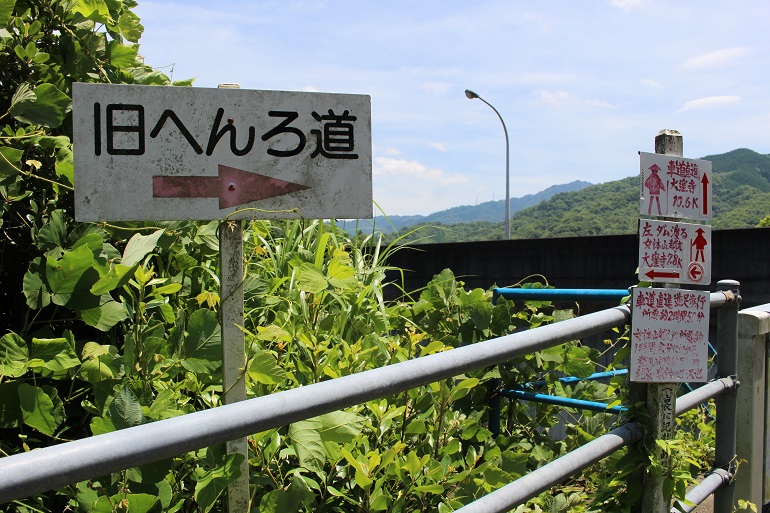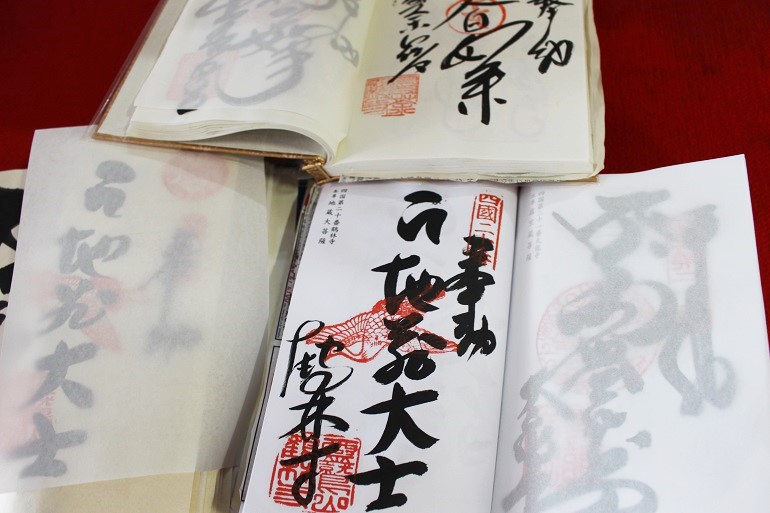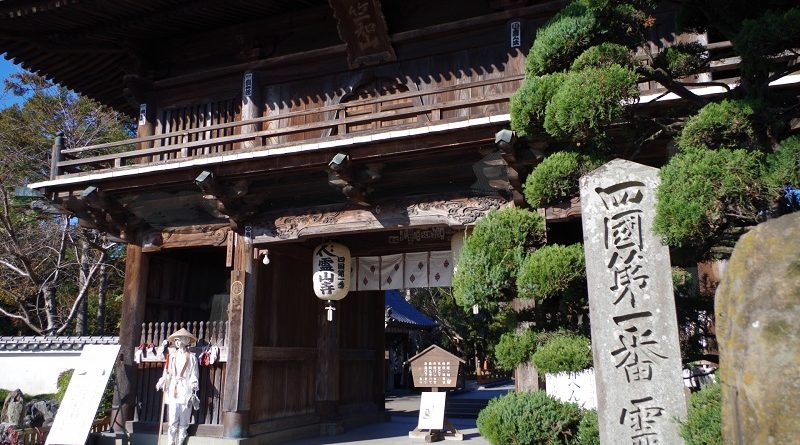Shikoku 88 Temple Pilgrimage
What is the OHENRO “Shikoku pilgrimage”?

About 1,200 years ago, the famed Buddhist monk Kukai (Kobo Daishi), established this pilgrimage route through the 88 temples in Shikoku to prevent people‘s calamity and disaster.
Originally, the pilgrimage route was visited by the monks of the Shingon sect for the purpose of worship, practice ascetic training and study to follow in Kobo Daishi’s footsteps and it started to spread among the common people from Edo period.
Temples on the pilgrimage route are called FUDASHO, its name originally came from pilgrims nailing a FUDA, amulets made from paper or wood to the pillar or ceiling of the temple . The act of traveling all FUDASHO is known to receive a blessing, which surpasses 1,400 km (870 miles).
Henro is also called Shikoku Jyunrei(四国巡礼), Shikoku Pilgrimage(四国遍路) and Shikoku Jyunpai(四国巡拝) and are still believed that the spirit of Kobo Daishi is still traveling those temples to this day.
It is not necessary to visit the temples in order; you can visit any temples you want.
Traveling clockwise from the #1 temple to the #88 temple around Shikoku is called JUN-UCHI (順打ち), traveling counterclockwise from #88 to #1 temple is called GYAKU-UCHI (逆打ち). Kobo Daishi traveled the pilgrimage by JYUN-UCHI and as the sign posts have become fewer and have lessened in quality, and the route has become harder to travel, traveling GYAKU-UCHI has become known to have a better chance to meet Kobo Daishi’s spirit during the journey.
When you travel GYAKU-UCHI on a leap year, it is said that you are recieving three times more blessing than JUN-UCHI in the same year. Other than that, travelling the whole pilgrimage of the 88 temples one time is called TOSHI-UCHI(通し打ち), finishing the whole pilgrimage of the 88 temples in several stages over a long period of time is called KUGIRI-UCHI (区切り打ち) . Traveling temples in only one prefecture (Shikoku is divided in to four prefectures) is called ITTKOKU-MAIRI(一国参り), Also there is BETTKAKU-20KASYO MEGURI (別格20か所巡り) which there are 20 other temples in addition to the 88 “official” temples of the pilgrimage.
In recent years, the Shikoku pilgrimage has become very popular. It is not as much of a religious occasion in today’s terms, a variety of people, from young to old, even people from different countries travel the pilgrimage with variety of purposes such as praying for good health, better fortune and their soul-searching journey.
The pilgrims travel by foot, bicycle, car, bus or taxi. They even have a bus tour. The most modern-day pilgrims travel by tour bus. It takes about 50 days to complete it by foot, about 20 days by bicycle and 10 days by car.
What To Wear
The number of prigrims with causal clothes are increasing in recent yeas, but formal pilgrimage outfits are still very popular and a pilgrim should wear the following:
1-Sugegasa (菅笠) Asian Straw Hut
The hat is usually marked with the word DOUGYO-NININ 同行二人 “We walk together” which represents the pilgrims and Kobo Daishi. During the Pilgrimage journey, it is believed that the traveler is not alone, Kobo Daishi is always near and protecting him/her through their journey.
2-Byakue (白衣 ) White Shirt
3-Ohenro Zubon (お遍路ズボン) White Trousers
4-Wagesa (輪架娑) Stole
5-Wagesa-dome (輪架娑止め) Wagesa Stopper
6-Gya-han (脚半)Gaiter(Japanese Leggings)
7-Kongō-zue (金剛杖) Pilgrim’s Staff.
It represents the spirit of Kōbō Daishi and to support the pilgrim along the way.The white clothes represents burial clothing when you die and the staff becomes your grave post. This displays the pilgrims determination.
8-Osamefuda-bako (納札箱) Name Slipcase
9-Ji-rei (持鈴) Bell
10- Shu-kou (手甲) Gloves
11-Nenzu (念珠) Player Beads
12-Sanya (Bukuroさんや袋 ) Bag to put your personal items
*It is not necessary to purchase everything, bring only what you need.
Worship Method of temple

The following steps are recommended, but not mandatory.
1.Bow in front of the temple gate before entering. (Do the same when you leave)
2.Wash your hands and rinse your mouth at a wash basin(水屋).
By using the dipper at the washbasin, pour water on the left hand, then the right hand. Pour water in the palm of your left hand rinse your mouth. Finally, hold the dipper vertically so remaining water runs down and purifies the handle.
3.Offer the name-slip (納札) to the visiting card box
4.Light 3 incent sticks and 1 candle.
5.Put a donation into the offering box
6.Put your hands together and recite the sutras or offer a copy of a sutra to the temple.
*Process #3-6 are done at the both the Main Hall (本堂) and the Taishi Hall (大師堂)
GOSYUIN Receive the temple stamps in your NOKYOCHO (stamp book)

After worshiping at the temple, go to the Nokyo-Office (納経所) to get GOSYUIN (御朱印). GOSYUIN is the stamp, which shows the proof of worship at each of the temples. It has the temple’s name and the date of visit hand written in ink then a red stamp is placed on top of it. GOSYUIN are a representation of the principal object of worship at a temple like good luck charm, so you need to be careful and keep it in safe place.
Getting stamps are not mandatory but why not getting the very memorable element in making pilgrimage? There are three ways of getting GOSYUIN, getting stamps placed on the henro’s white shirt (朱印用白衣), hanging scroll (納経軸) and the most popular way is stamped in the NOKYOCHO stamp book (納経帳).
The cost of GOSYUIN is around ¥300 each and you can get the stamp at the same place any number of times.
The SETTAI Offering
During the pilgrimage, pilgrims might have a moment to be offered some free food or drinks, as well as offers for a ride in their car and even the places to spend the night by the kind locals from Shikoku.
SETTAI (hospitality) offering, of course shows the kindness and support from the people in Shikoku island, it also is considered to have the meaning for the people who show kindness to the pilgrims with the wish of “Please pray at the temple on my behalf” and receiving good fortune from the gods by supporting the pilgrims. Some people believe that giving support to the pilgrims is a good way to purify their own spirit without going to the temples themselves. Therefore, it is basically, it’s a custom for the pilgrim to not refuse any offer.
When the pilgrim receives the SETTAI offering, he/she puts their hands together and says the phase “Namu Daishi henjo kongo (南無大師遍照金剛)” three times. The custom of the SETTAI offering started from the Edo period and it become custom all across Japan, but only in Shikoku, this custom remains to this day.
2016 is a leap year that means traveling GYAKU-UCHI receives huge fortune.
Whether travelling OHENRO for religious purposes, praying for something, sightseeing or for any other purpose, please have a safe pilgrimage, receive SETTAI and feel the warmth and kindness of the people of Shikoku island.

